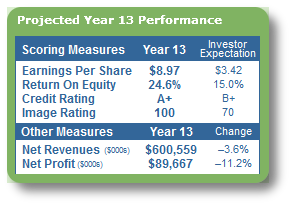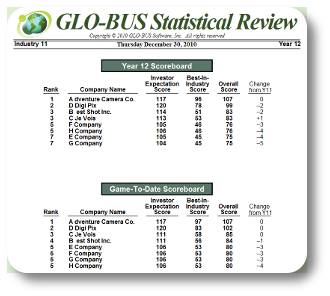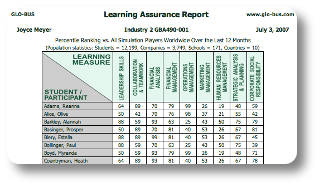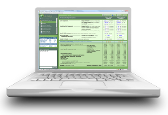In GLO-BUS, 1 to 5 class members are assigned to run a digital camera company that produces and markets entry-level and upscale, multi-featured cameras in head-to-head competition against camera companies run by other members of the class. As many as 12 companies can compete in a single industry grouping (class sizes above 50 are typically divided into two or more industry groups). The companies compete in a global market arena, selling to camera retailers in four geographic regions—Europe-Africa, North America, Asia-Pacific, and Latin America.
The co-managers of each company are responsible for assessing market conditions, determining how to respond to the actions of competitors, forging a long-term direction and strategy for their company, and making decisions relating to:
- R&D, camera components, and camera performance (up to 10 decisions)
- Assembly operations and worker compensation (up to 15 decisions for a single assembly plant)
- Pricing and marketing (up to 15 decisions in each geographic region)
- Corporate social responsibility and citizenship (as many as 6 decisions)
- Financing of company operations (as many as 4 decisions).
Each time co-managers make a decision entry, an assortment of on-screen calculations instantly shows the projected effects on unit sales, revenues, market shares, total profit, earnings per share, ROE, unit camera costs, and other pertinent operating outcomes, enabling co-managers to evaluate the relative merits of one decision entry versus another. Company managers can experiment with many different decision combinations in arriving at a decision combination and set of actions that seem likely to yield good company performance. In addition, there are 2-4 minute video tutorials for each decision screen and comprehensive Help sections that explain cause-effect relationships, provide tips and suggestions, explain how the numbers in the company and industry reports are calculated, and otherwise inform company co-managers how things work.

Each company typically seeks to enhance its performance and build competitive advantage via its own custom-tailored competitive strategy based on more attractive pricing, greater advertising, a wider selection of camera models, more appealing camera performance/quality, longer warranties, the amount/caliber of technical support provided to camera buyers, more aggressive sales promotion campaigns, and/or creating a stronger brand name reputation than rivals.
Any and all competitive strategy options—low-cost leadership, differentiation, best-cost provider, focused low-cost, and focused differentiation—are viable paths for a company to take. A company can have a strategy aimed at being the clear market leader in either entry-level cameras or multi-featured cameras or both. It can focus on one or two geographic regions or strive for geographic balance. It can pursue essentially the same strategy worldwide or craft slightly or very different strategies for each of the four geographic regions.
Each company's performance is based on a balanced scorecard that includes brand image, earnings per share, return on equity investment, stock price appreciation, and credit rating.
You have the option to schedule 1 or 2 practice rounds (2 is recommended) and anywhere from 4 to 10 regular/scored decision rounds (6 to 10 rounds are better than 3-5 rounds). Each decision round represents a year of company operations and takes roughly two hours for company co-managers to complete. Decision rounds can be scheduled weekly, bi-weekly, or at whatever intervals instructors wish. Sample schedules for courses of varying length and numbers of class meetings are provided.
When the instructor-specified deadline for a decision round arrives, the GLO-BUS server automatically accesses the saved decision entries of each company, determines the competitiveness and buyer appeal of each company's camera offerings relative to rival companies, and then allocates sales and market shares to the competing companies, geographic region by geographic region, based on:
- how each company's wholesale selling prices for its entry-level and multi-featured cameras compare against the corresponding industry-wide average prices being charged in each geographic region,
- how each company's camera performance and quality compares against that of rival brands
- how each company's advertising effort compares to rivals' advertising, and so on for each of the 11 competitive factors that determine unit camera sales and market shares.

There's no built-in bias favoring any one strategy and no "secret set of strategic moves" that are sure to result in a company becoming the industry leader. GLO-BUS is a "competition-based" strategy simulation exercise where the outcomes are always unique to the competitive interplay among the specific decisions and strategies of each group of competing companies. Which strategies end up delivering the best performance in any given group of 4 to 12 companies that are competing head-to-head always depends on the competitive interplay among the specific decisions and strategies of rival companies—there absolutely is no "magic bullet" strategy and no prescribed set of actions that will guarantee good company performance.
Company co-managers can access the results of the decision round 15-20 minutes after the decision deadline. Rankings of company performance, along with a wealth of industry and company statistics, are available to company co-managers after each decision round to use in making strategy adjustments and decisions for the next competitive round.
All GLO-BUS activities for class members and instructors take place here at www.glo-bus.com.
There are three exceptionally important teaching/learning benefits associated with using a competition- based simulation like GLO-BUS:
-

Having class members run a company in head-to-head competition against companies managed by other class members provides a truly powerful learning experience that thrusts class members squarely into an active, hands-on managerial role. The co-managers of each company are totally responsible for assessing market conditions, determining how to respond to the actions of competitors, forging a long-term direction and strategy for their company, and making decisions relating to workforce compensation and plant operations, assembly plant capacity, pricing and marketing, finance, and corporate social responsibility/citizenship.
Because company co-managers are held fully accountable for their decisions and their company’s performance, they are strongly motivated to dig deeply into company operations, probe for ways to be more cost-efficient and competitive, and ferret out strategic moves and decisions calculated to boost company performance. It doesn’t take long for company co-managers to become emotionally invested in figuring out what strategic moves to make to out-compete rivals. Such diligent and purposeful actions on the part of company co-managers translate into an engaging learning experience with strong retention of the lessons learned and higher achievement of course learning objectives.
To provide you with quantitative evidence of the boost in learning power and achievement of course objectives that occurs with using GLO-BUS, there is a built-in Learning Assurance Report showing how well each class member performs on 9 skills/learning measures versus tens of thousands of students at some 300+ campuses worldwide that used GLO-BUS in the past 12 months.
The competitive nature of a strategy simulation arouses positive energy and steps up the whole tempo of the course by a notch or two. The healthy rivalry that emerges among the management teams of competing companies stirs competitive juices and spurs class members to fully exercise their strategic wits, analytical skills, and decision-making prowess—much more so than occurs with many other types of assignments.
Nothing energizes a class quicker or better than concerted efforts on the part of class members to gain a high industry ranking and avoid the perilous consequences of getting outcompeted by class members running rival companies. It is hard to duplicate the excitement and hallway chatter that occurs when the results of the latest decision round become available and co-managers renew their quest for strategic moves and actions that will strengthen company performance.
Participating in a competition-based strategy simulation is an unusually stimulating and enjoyable way for class members to learn. As soon as your students start to say “Wow! Not only is this fun but I am learning a lot”, which they will, you have moved the value of taking your course to a much higher plateau in the business school curriculum. This translates into a livelier, richer learning experience from a student perspective and better instructor-course evaluations..
The automated nature of GLO-BUS reduces the time instructors spend on course preparation, course administration, and grading. Not only are administrative requirements for using GLO-BUS quite modest, but since the simulation also involves a 20 to 30-hour workload for student-teams (roughly 2 hours per decision round times 10-12 rounds, plus optional GLO-BUS -related assignments), adopters often compensate by trimming the volume of other course assignments (often those that entail considerable preparation and/or grading on the instructor’s part). Grading for GLO-BUS is effortless and takes only minutes. Once you enter percentage grading weights for each GLO-BUS activity in your online grade book, an overall numerical grade is automatically calculated for each class member.
Course preparation time is further cut because you can use several class days to have class members meet in the computer lab to work on upcoming decision rounds or a 3-year strategic plan (in lieu of lecturing on a chapter or covering an additional assigned case). Lab sessions provide a splendid opportunity for you to visit with teams, observe the interplay among co-managers, and view the caliber of the learning experience that is going on.
The speed and ease with which you can conduct a fully-automated strategy simulation for your course frees time for other activities. Plus, every task can be performed from an office or home PC that has an Internet connection and an Internet browser.
|
Simulation-only
Option
$ 44.95
per student
|
Complete Strategy Text + Simulation + Optional Cases
$ 99.95
per student
|
| Simulation Features | ||
 |
Full Instructor Access to All Materials at No Cost |
 |
 |
24/7/365 Online Availability |  |
 |
Built-in Voice Chat and Shared-Screen Collaboration Capabilities (Team members can have online meetings to talk, text, and coordinate decision entries and view reports; instructors can join these meetings) |
 |
 |
Windows & Mac Compatibility |  |
 |
3-Year Strategic Plan Option |  |
 |
2 Built-in Quizzes |  |
 |
Team Member Peer Evaluations |  |
 |
Scoreboard of Company Performance |  |
 |
Player's Guide |  |
 |
Instructor's Manual |  |
 |
Integrated & Automated Gradebook |  |
 |
Learning Assurance Report |  |
| Features of Accompanying Text Strategy: Core Concepts and Analytical Approaches, 2012 Edition |
||
 |
12 Chapters, 242 pages (a slimmed-down version of Crafting and Executing Strategy, published by McGraw-Hill) |
 |
 |
Exercises Linking Chapters to Simulation |  |
 |
Chapter Quizzes / Multi-Chapter Exams |  |
 |
Learning Assurance Report |  |
 |
Integrated & Automated Gradebook |  |
 |
PowerPoint Slides for Chapters |  |
 |
View more details on the digitally-delivered text |  |
| Optional Cases | ||
 |
26 Digitally-Delivered Selections, Each with a Comprehensive Teaching Note (additional cost of $5.00 per case per student) |
 |
| Three Payment Options (click for more details) |
||
 |
Credit Card |  |
 |
Pre-Paid Access Code |  |
 |
Direct Billing |  |

The Learning Assurance Report provides you with solid empirical data regarding the business skills and decision-making capabilities of the students in your class relative to students at other business schools across the world.
The report provides you with credible evidence about the business proficiencies of your students on each of 9 measures that are precisely defined at the bottom of the report. The three measures relating to "Leadership Skills", "Collaboration & Teamwork", and "Financial Analysis Skills" are based on each student's individual performance as viewed by their company co-managers and their performance on Quiz 2; the other 5 measures are all based on data relating to the performance of the group of co-managers comprising each company in the simulation. The percentiles shown in the report are based on the total population of students worldwide playing GLO-BUS over the past twelve months.

Create an Instructor Account
Explore the Instructor Center, and determine whether GLO-BUS is suitable for your course.
Creating an account is welcomed and entails no obligation. Establishing an account entitles you to browse the site in the capacity of an instructor or "simulation administrator", preview whether GLO-BUS is suitable for use in your course (or company training program), and enables you to launch use of GLO-BUS in a course or training program for which you are the official instructor or facilitator or other duly authorized assistant. McGraw-Hill will verify your credentials and, in some cases, it is possible that a McGraw-Hill representative will contact you by phone or e-mail soon to confirm your status.
User Agreement
Should I adopt GLO-BUS for use in my course, I agree to require every student enrolled in my course to register a student account at the GLO-BUS Web site (www.glo-bus.com) and I agree to encourage student respect for the intellectual property and copyrights of the authors and the publisher, McGraw-Hill.
I understand that GLO-BUS will inform me via e-mail when there are important system changes, program updates, or special events that impact the use of GLO-BUS in courses that I am teaching.



